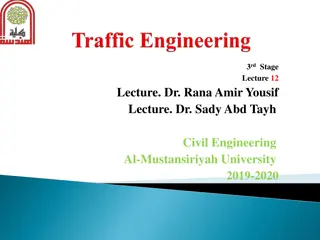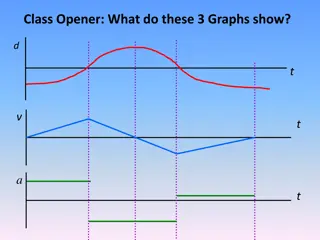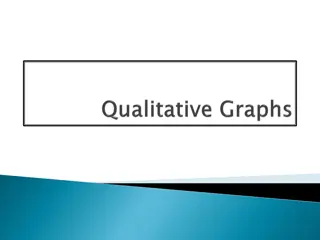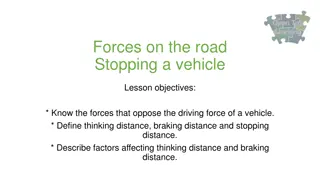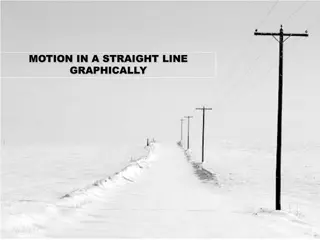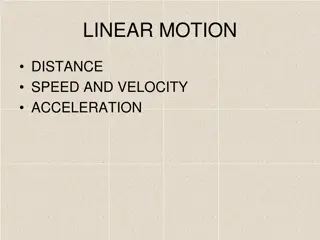Understanding Distance vs. Time Graphs in Motion Analysis
Explore the analysis of motion through distance vs. time graphs, including recognizing speed and acceleration, interpreting motion, calculating slopes, and determining changes in velocity. Learn how to describe motion journeys and understand the significance of graph components in depicting object movement.
Download Presentation

Please find below an Image/Link to download the presentation.
The content on the website is provided AS IS for your information and personal use only. It may not be sold, licensed, or shared on other websites without obtaining consent from the author. Download presentation by click this link. If you encounter any issues during the download, it is possible that the publisher has removed the file from their server.
E N D
Presentation Transcript
Distance vs. Time Graphs Analysis of a Distance (d) vs Time (T) Graph
Learning Objectives I can recognize speed on a distance vs. time graph. I can recognize acceleration on a distance vs. time graph. I can analyze motion on a distance vs. time graph. I can calculate slope (speed) on a distance vs. time graph.
Motion showed on a Motion showed on a Distance (d) Distance (d) vs. vs. Time (t) Time (t) Graph Graph Where did the object start? Which direction did it go? Where did the object stop Is the motion constant? Is the motion changing? Can you tell which is faster (if 2 or more objects are present)
Distance (d) vs. Time (t) Distance (d) vs. Time (t) Graph Graph Describing a journey made by an object is not exciting if you just use words. As with much of science, graphs are revealing. more Plotting distance against time can tell you a lot about a journey. Let's look a closer look:
Distance (d) Vs. Time (t) Graph Distance (d) Vs. Time (t) Graph Time always runs horizontally (the x-axis). The arrow shows the direction of time. The further to the right, the longer time from the start. Distance runs vertically (the y-axis). The higher up the graph we go, the further we are from the start.
What type of Graph is This? Explain Why. (Hint: Think of what is on the axes and how to find slope) D D t t
This is a speed graph because it shows a change in distance over time (s = d/t). The slope of the line on the graph will equal the speed. SLOPE = SPEED (higher slope = faster speed) ???? ??? ???????? ???? ????? ????? = = = D D t t
Interpreting Velocity on a Graph You can use the slope of a line to find Velocity [ ] Dis tan ce m Velocity = [ ] Time s 15 m More Distance In Less Time (Faster) Distance 10 m 5 m Less Distance In More Time (Slower) 5 s 15 s 10 s Time Think of the Velocity graph this way: Which one of these balls will fall faster? The graph with more steepness is the faster velocity. The less steep, the slower.
What would a graph showing an object moving at a constant speed look like? Try to draw it. D D t t
Constant speed Constant speed D D t t
Now, on the same graph, use a dashed line to show a second object with a SLOWER constant speed 2 constant speeds, one faster, one slower D D t t
Try drawing a speed graph that shows an object that speeds up. What do we call this motion? Acceleration D D t t
Try drawing a speed graph that shows an object that slows down. What do we call this motion? Deceleration D D t t
Try drawing a speed graph that shows an object that is going backwards at a constant speed. D D t t
Try drawing a speed graph that shows an object that is going backwards slowing down. D D t t
Try drawing a speed graph that shows an object that is going backwards speeding up. D D t t
Try drawing a speed graph that shows an object that is stopped. D D t t
As a group, describe how fast the object is probably Q: What should you learn from this? A: Steep lines on motion graphs, mean an object is moving Interpreting Speed on a Graph: moving as you travel along the line (left to right) (After you try it together, click to see the real motion) quickly! Non-steep lines mean the object is moving slowly! Q: HOW CAN YOU TELL?!?! It can help to think about the speed of a rolling ball on the slope 15 m Distance Now it s moving fast! 10 m This ball would roll fast! This ball would roll slowly 5 m Started slowly Stopped moving! This ball won t roll at all! 5 s 10 s 15 s Time
Try drawing a speed graph that shows an object that travels at a constant speed, then slows down, then comes to a stop? D D t t
A speed graph that shows an object that travels at a constant speed, then slows down, then comes to a stop? deceleration stopped constant speed D D t t
Try drawing a speed graph that shows an object that accelerates, then decelerates, comes to a stop, then moves backwards at a constant speed? D D t t
A speed graph that shows an object that accelerates, then decelerates, comes to a stop, then moves backwards at a constant speed? stops backwards at a constant speed decelerates accelerates D D t t
Graphing Velocity Graphing Velocity Graphs can help us Interpret what has actually happened! The shape of the line and steepness of the slope can tell us what has happened and how fast it occurred! That s right! We are NOT done with graphs!!! We are only just beginning!!! What you want to be able to do is know what the graph is telling you by looking at the line
Find the speed/slope for A Slope = rise run = distance Y2 = time = y2 y1 2400m X2 X1 = Speed ???? ???= y2 y1 X2 X1 = A A) 2400m - 0m = 30min - 0min 2400m 30min=80m/min B C D 0m Y1 = 0min X1 = 30min X2 =
Find the speed/slope for B Slope = rise run = distance time = y2 y1 X2 X1 = Speed B) ???? ???= y2 y1 X2 X1 = A 1200m - 400m = 30min - 20min 1200m Y2 = 800m 10min=80m/min B C 20min 400m 30min Y1 = X2 = X1 = D
Find the speed/slope for D Slope = rise run = distance time = y2 y1 X2 X1 = Speed D) ???? ???= y2 y1 X2 X1 = A 400m - 0m = 10min - 0min 400m 10min=40m/min B C 400m Y2 = D 0m Y1 = 10min 0min X1 = X2 =
All the speeds Slope = rise run = distance time = y2 y1 X2 X1 = Speed X2 X1 = 2400m 0m 2400m 30??? = 80m/min B) y2 y1 30min 20??? = 800m 10??? = 80m/min D) y2 y1 X2 X1 = 400m 10??? = 40m/min A) y2 y1 30min 0??? = A X2 X1 = 1200m 400m B 400m 0m 10min 0??? = C D
Different Slopes 8 7 6 5 4 3 2 1 0 Slope =Rise/Run = 0 km/1hr = 0km/hr Distance(km) Rise = 2km Run =1 hr Rise = 0k m R un = 1h r Slope =Rise/Run =2 =2 km/hr km/1hr Rise = 1 km Run =1hr 4 1 2 3 5 6 7 Slope =Rise/Run = 1 km/1hr = 1 km/hr Time (hr)
Find the Average speed of the Entire Find the Average speed of the Entire Trip and draw it on the graph. Trip and draw it on the graph. Slope = rise run = distance Y2 = time = y2 y1 4mil X2 X1 = Speed ???? ???= y2 y1 X2 X1 = 4 mil -0 mil = 10min - 0min 4 mil 10min= .40mil/min Y1 = 10min 0 mil 0min X1 = X2 =
Draw the Average Speed Line on the Draw the Average Speed Line on the Graph Graph Slope = rise run = distance Y2 = time = y2 y1 4mil X2 X1 = Speed Now that we know that the average speed is .40mil/min. Lets draw the average speed line. 1. Connect the origin to the last point with a straight line. This is the average speed for the entire trip. 0 mil Y1 = 0min X1 = 10min X2 =
Question: Find the average speed for the entire trip. Than Draw it. Slope = rise X2 X1 = Speed (Average) Slope = rise run = distance run = Total distance time = y2 y1 Total time = 12km 2km/hr = 6hr 14 12 10 Distance(km) 8 6 4 2 0 Rise = 12km 0 1 2 Run = 6hr 3 4 5 6 Ti me (hr)
Big Ideas Big Ideas Slope of a distance vs. time graph represents speed. A flat line on a distance vs. time graph means you are not moving. D D t t
Big Ideas Big Ideas A negative trend line on a distance vs. time graph means you are going backwards. D D D D D D t t t t t t














